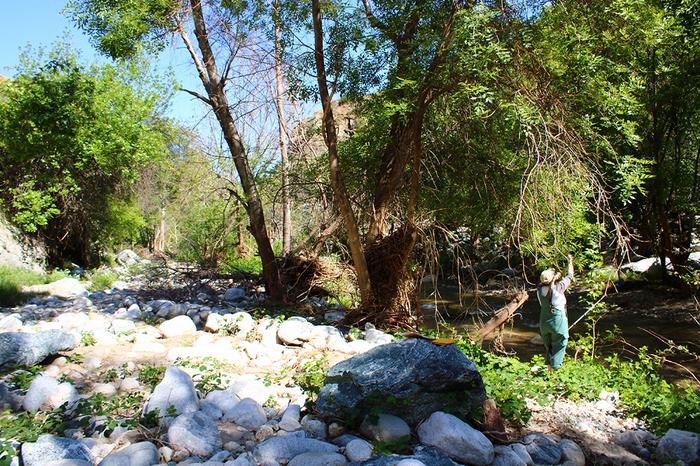
The emerald ash borer (EAB), a small but devastating wood-boring beetle native to Asia, has wreaked havoc on ash tree populations across North America since its introduction into the United States in 2002. Initially discovered in southeast Michigan, this invasive species has since spread across the country, decimating tens of millions of ash trees. The implications of this widespread destruction are severe, with EAB responsible for one of the costliest insect invasions on record. Its relentless assault threatens to render the ash tree functionally extinct, a scenario that would disrupt the ecological balance in regions where these trees play a vital role. Researchers from Penn State University, in collaboration with the U.S. Forest Service and various partners, are racing against time to devise strategies to save ash trees through genetic resilience against the EAB.
A particular focus has emerged on the Oregon ash (Fraxinus latifolia), a species crucial to the ecosystems of the Pacific Northwest. Oregon ash provides significant wildlife habitat, stabilizes streambanks with its extensive root systems, and contributes to the cooling of waterways by casting shade. Furthermore, these trees serve as an important food source for various bird species and insects. In light of the EAB threat, researchers have turned their attention to developing ash tree strains that can endure both the savage attacks of the beetle and the increasing heat associated with climate change.
In their latest study, published in the prestigious journal Molecular Ecology, scientists at the Louis W. Schatz Center for Tree Molecular Genetics at Penn State uncovered substantial genomic variation among Oregon ash populations. By examining trees across a geographic range that stretches from California through Oregon and into British Columbia, researchers determined that the genetic differences among trees were shaped not only by their immediate environmental conditions but also by their demography and connectivity to other populations. This groundbreaking understanding of the genetic architecture of Oregon ash lays a foundation for the development of ash trees that are more resilient to both biotic threats, like EAB, and abiotic stresses, particularly those instigated by climate change.
Researchers quantified the genomic variations among over 1,000 individual trees from 61 distinct populations, providing an unprecedented view into the genetic diversity of Oregon ash. They found marked differences in how these trees might adapt to the anticipated challenges of climate variations. The concept of “genomic offset” emerged from their work, representing the genetic shifts required for trees to thrive under future climate scenarios. These genomic alterations are paramount, given that different regions within the ash’s range exhibited varied levels of genomic shifts necessary for adaptation. Findings implicate that the mosaic-like distribution of ash populations could impact the overall evolutionary potential of this species in the long term.
Study senior author Dr. Jill Hamilton emphasized the urgency of their research, particularly in the context of the EAB’s alarming spread into new territories like Oregon and British Columbia. Knowledge of how quickly mortality rates climb in infested Oregon ash trees indicates that proactive measures are imperative for preservation. Hamilton articulated a vision that transcends immediate concerns; it aims to understand and maintain genetic diversity necessary for developing robust breeding strategies that can combat the EAB threat and ensure the long-term conservation of ash trees.
To achieve this, landscape genomics emerged as a powerful tool within their research arsenal. This methodology enables scientists to pinpoint specific populations of Oregon ash that are most vital for conservation efforts. It serves to refine the selection process for breeding programs aimed at creating trees that hold the characteristics for both survival against invasive species and adaptability to changing climate conditions. The researchers’ evidence reflects a critical need to prioritize the conservation of genetic variability across the species’ range, which could enhance the effectiveness of expanding collections for genetic maintenance and resilience breeding.
The real-world applications of this study stretch beyond academia, having significant implications for forestry management and ecological restoration initiatives throughout the affected regions. With a concerted approach to conservation genetics, this research represents a turning point; it showcases how genomic data can directly inform restoration practices for Oregon ash in the face of an impending ecological crisis driven by EAB.
In addition to Hamilton, the study featured collaboration from several esteemed scientists, including Anthony Melton, a postdoctoral scholar at Penn State who is now a biology professor at the University of Montevallo. Others contributing to this pivotal research included experts from the U.S. Geological Survey and the U.S. Forest Service, each bringing unique insights and methodologies that enriched the overall findings.
As society grapples with the dual challenges of invasive species and climate change, the effort to study the genetic resilience of Oregon ash reveals a blueprint for how scientific inquiry can translate into actionable conservation strategies. The invaluable insights bestowed by genomic studies are set to reshape the future course of ash tree management, offering a glimmer of hope amid alarming ecological shifts.
In conclusion, continued efforts to monitor and understand Oregon ash through genomics must be met with robust conservation practices. The insights gleaned from this research hold profound implications not only for ash trees but also for the broader ecosystems they support. Bolstering the genetic diversity within these populations could pave the way for a more resilient future, ultimately ensuring that Oregon ash trees continue to play their indispensable roles within their ecosystems for generations to come.
Subject of Research: Genetic diversity and resilience of Oregon ash trees (Fraxinus latifolia)
Article Title: Genomics-Driven Monitoring of Fraxinus latifolia (Oregon Ash) to Inform Conservation and EAB-Resistance Breeding
News Publication Date: 6-Jan-2025
Web References: Molecular Ecology Journal
References: U.S. Department of Agriculture National Institute of Food and Agriculture
Image Credits: Penn State
Keywords: Genomics, Invasive Species, Oregon Ash, Emerald Ash Borer, Conservation Genetics, Climate Change, Biodiversity, Forest Ecology, Genetic Diversity.





